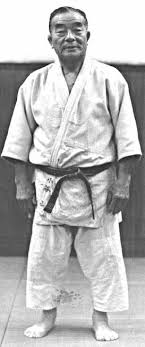
The Committee for the development of self-defense methods within the Kodokan was established in September of 1952. It was lead by Nagaoka, Mifune and Samura. As Nagaoaka already passed away just two months after this (He died in November of 1952), his influence on goshinjutsu is insignificant, at least directly. Nagaoka was a crucial figure in Kime-no-kata and likely in this way did leave some inheritance.
The original committee existed of not less than 25 people, all the way from 7th dan to 10th dan, of which Tomiki Kenji's name likely has been most known as connected to goshinjutsu. Tomiki in that time was a 7th dan, and some of the later famous judoists such as Kotani (later 10th dan) and Kudo (later 9th dan) were 8th dan. There were also three 9th dan-holders (at the time): Oda, Kurihara (later 10th dan) and Nakano (later 10th dan). It is Kotani who probably became the greatest and best known expert of goshinjutsu, and his performance in this kata was impressive. Too bad the Kodokan hasn't published the video. It exists in color, and I have it somewhere under a layer of dust. I guess I should transfer it to DVD at some occasion, before it fades more.

There do not exist any scientific or history books on Kodokan 's goshinjutsu. The leading works are those that Tomiki wrote in 1956 and which has been reprinted numerous times and Kotani's book which he published with Hirose and Ozawa. Tomiki's book can still be found on secondhand markets without too much difficulty, except for the fact that some idiots will try to charge horrendous prices for it. Expect to pay anything from $40-$120 for it, though it is a pretty thin book printed on bad quality paper with very poor quality pictures.
In the early 1960's Tomiki himself used to teach it as part of the summer course, and there are still some Americans left who must have learnt goshinjutsu from him firsthand. I'm thinking of such people as Jack Williams and Hal Sharp, both now shichidan.

Goshinjutsu HAD to be different from Kime-no-kata. The Idori in Kime-no-kata was still remniscent of the Edo-period, with a samurai visiting a daimyo, depositing his katana at the entrance, and wearing only his (clothes and) wakizashi. In modern Japan or the West, no one does this anymore, and even the Japanese use chairs and tables. Idori is therefore superseded by time.
Two out of the three weapons used in Kime-no-kata (though the third weapon, the wakizashi, is twice only mimicked and symbolized by the tanto to reduce the number or returns and complications) are not really carried as by any modern potential attacker, except for a weirdo. Yes, the above is NOT an error, kime-no-kata DOES have three weapons, NOT two as most of you may think, and most books will suggest. Both 'kiri' attacks in the idori and tachi-ai are performed by a(n) (imaginary) wakizashi, not tanto. It was also never felt necessary to actually use two different mock weapons to simulate either one; after all, lengthwise there isn't much difference, and a long tanto can actually be longer than a short wakizashi.
In goshinjutsu, the weapons are either everyday common weapons (stick or jo, knife of tanto) as well as modern developments (pistol or kenjo).
In terms of its techniques, goshinjutsu goes outside of the standard judo curriculum and introduces wrist locks, whereas it avoids going back to previously deserted judo techniques such as neck- or leglocks. Kano Jigoro's admiration for aikido was empasized earlier by sending both Tomiki and Mochizuki to Ueshiba's dojo. The effectiveness of aikido was obvious, and the art was able to achieve this by meticulously adhering to its principles, and unlike in judo avoid an over-reliance on physical force, which was often seen during major contests; in addition, aikido preserved high educational values, and like judo succeeded in doing something jujutsu failed at, that is, go all the way without producing major injuries to important joints. Aikido's ikkyo, nikyo, sankyo proved to be very effective techniques, and so was its principle of kote-gaeshi and kote-hineri. Those locks could be learnt without needing to have great proficiency in aikido. The same would not be true for example with techniques such as irimi-nage or kokyu-nage.

Though Kano himself was no longer part of this entire ordeal, and we do not have any proof that this is what he wanted, he had commented that he considered aikido as the "ideal budo" hence implicitly admitting the limitations of his judo. Towards the end of his life, Kano became more and more aware of certain failure of judo, not necessarily because the system was flawed, but because the way it was being practised was increasingly deviating from his ideas. He tried remedying this by conceding that a return to ko-ryu was necessary. Judo and ko-ryu would need to be blended in. The Kodokan itself suppressed these ideas after Kano's death, possibly because of a certain right-wing identification of ko-ryu and its illegitimization by MacArthur. It emphasis as sport, likely helped judo being allowed sooner to be practised again, unlike ko-ryu arts.
Orginal Thread on JudoForum
A rough version of the kata being demoed.







No comments:
Post a Comment